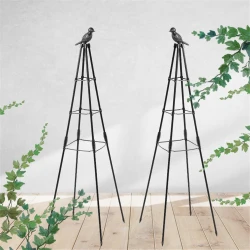Common types of plant support and trellis systems
2023-12-04
Plant supports and trellises are essential tools for gardeners to help plants grow upright, provide structural support, and maximize space. They also contribute to better air circulation and sunlight exposure, promoting healthier plants. Here are common types of plant support and trellis systems:
Plant Supports:
1. Stakes:
- Vertical supports placed in the soil to prop up individual plants.
- Ideal for tall or top-heavy plants that may otherwise droop.
2. Cages:
- Wire or wooden structures encircling plants to provide support.
- Commonly used for tomatoes and other bushy plants.
3. Pea and Bean Netting:
- Mesh nets for supporting climbing vegetables like peas and beans.
- Can be draped over frames or attached to stakes.
4. Grow-through Rings:
- Metal or plastic rings placed around the base of plants.
- Allow the plant to grow through while providing support.
5. Tripods:
- Three-legged structures that create a stable base for supporting plants.
- Often used for tall and climbing plants.
6. Hoops or Cages with Netting:
- Wire or plastic hoops covered with netting.
- Protect plants from pests while providing support.
7. Tomato Cages:
- Cone-shaped wire cages designed for supporting tomato plants.
- Allow the plant to grow upward and prevent sprawling.
Trellises:
1. Wooden Trellises:
- Vertical wooden structures with crisscrossed slats.
- Provide a rustic and natural look, often used for climbing plants.
2. Metal Trellises:
- Sturdy metal frames with decorative designs.
- Suitable for supporting climbing flowers or vegetables.
3. Arbors:
- Arch-shaped structures with open sides.
- Add aesthetic appeal and provide support for climbing plants.
4. Obelisks:
- Tall, pyramid-shaped structures with a pointed top.
- Used for supporting climbing plants and as decorative garden elements.
5. Bamboo Trellises:
- Made from bamboo poles or stakes.
- Lightweight and eco-friendly, suitable for various climbing plants.
6. Pergolas:
- Larger structures with open sides and a framework of vertical posts.
- Create shaded walkways or seating areas with climbing plants.
7. Wall-Mounted Trellises:
- Attached to walls or fences to support climbing plants vertically.
- Save space and add vertical interest to garden walls.
8. String or Wire Trellises:
- Horizontal wires or strings attached to vertical supports.
- Ideal for training vines or espaliered fruit trees.
9. Teepee Trellises:
- Three or more poles arranged in a teepee shape.
- Provide support for climbing plants and a unique garden feature.
10. A-Frame Trellises:
- Two triangular frames joined at the top to create an A shape.
- Support climbing plants and add structure to the garden.
11. Fan or Espalier Trellises:
- Horizontal and vertical wires arranged in a fan shape.
- Used for training fruit trees or ornamental plants against a wall.
12. Mesh or Grid Trellises:
- Grid-like structures made of metal or wood.
- Suitable for supporting vines, flowers, or vegetables.
13. Ladder Trellises:
- Ladder-shaped structures with horizontal steps.
- Provide climbing support and a unique visual element.
14. Retractable Trellises:
- Can be expanded or collapsed to adjust to plant growth.
- Ideal for spaces with limited room.
15. DIY Trellis Ideas:
- Creatively repurpose materials like old ladders, wooden pallets, or discarded items to make unique trellises.
When choosing plant supports and trellises, consider the growth habits of your plants, the available space, and the overall aesthetic of your garden. Properly installed supports contribute to the health and productivity of your plants while adding structure and visual interest to your garden.



